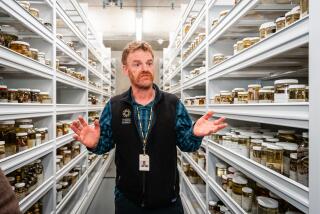Hawaii Refuses to Welcome Slithering Lethal Visitors
- Share via
HONOLULU — Brown and sometimes reaching 10 feet long, it has a ruthless appetite for destruction. Birds, rodents and bats are typical victims, but it’s also been known to attack infants with nearly fatal results.
Hawaii, with more endangered species than any other U.S. state, is mustering everything it can to prevent an invasion of the brown tree snake. State officials have deployed an elite battalion of beagles to sniff out incoming cargo from Guam, 3,800 miles to the southwest, where the snakes have already decimated native bird populations.
“The brown tree snake is the major enemy alien species threat to the state of Hawaii,” said Mike Wilson, director of the state Department of Land and Natural Resources. “Virtually every single bird species we have” would be threatened by the snake, he said.
Since Jack Russell terriers first were used on Guam in 1994 to check outgoing cargo, only one brown tree snake has been confirmed arriving in Hawaii, said Mike Pitzler of the U.S. Department of Agriculture’s snake containment program in Hagatna, Guam. That compares with five snakes found in the previous five years.
Still, it takes only one pregnant snake to breach Hawaii’s defenses, since a female can lay up to 12 eggs at a time.
“A number of snakes we have captured have been females in various stages of pregnancy,” Pitzler said.
Every night on Guam, where the brown snake first arrived in the 1940s, the director of the U.S. territory’s Agriculture Department goes out to an area near his local airport to hunt for snakes. And each night Mike Kuhlmann finds the slithery critters that have run rampant.
Guam and the federal government have spent millions of dollars trying to repair the damage. About 10,000 snakes a year are captured on Guam, but money can’t fix it all: The snake is believed responsible for eliminating nine of the island’s 11 native bird species.
“What is the dollar value of losing a species? How do you calculate it?” Kuhlmann said.
Guam plans to reintroduce a decimated bird species, the ko’ko’, also called the Guam rail. Thirteen breeding pairs will be released on 65 acres of Andersen Air Force Base that have been cleared of enough snakes to be habitable for the flightless birds.
The land, known as Area 50, is ringed with a 7-foot-high chain-link fence that prevents snakes from reentering, Kuhlmann said.
It seems to be working: Last year, 140 snake traps in the area snagged up to 40 snakes a week; now only a few snakes are captured per week.
The ko’ko’ is the only native bird species exclusive to Guam. They and other bird species nearly wiped out by the snake were kept alive in captive breeding programs.
The success of the ko’ko’s reintroduction will help determine whether other birds will be returned to Guam, Kuhlmann said.
“There is more work ahead than there is behind,” he said, citing a need for better, cheaper snake bait than the live mice now used.
Guam can count on Hawaii, since billions of dollars depend on the snake not reaching its shores.
Hawaii’s snake defense is financed mostly by Congress. For the coming fiscal year, a Senate subcommittee has recommended $2.6 million in anti-snake money.
More to Read
Sign up for Essential California
The most important California stories and recommendations in your inbox every morning.
You may occasionally receive promotional content from the Los Angeles Times.










